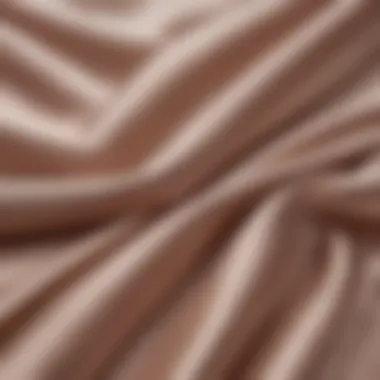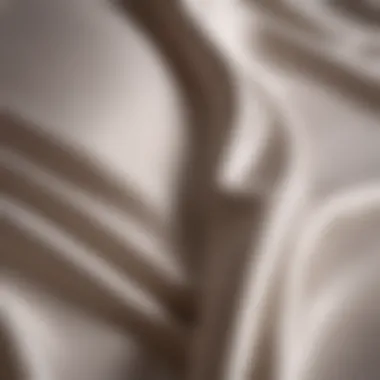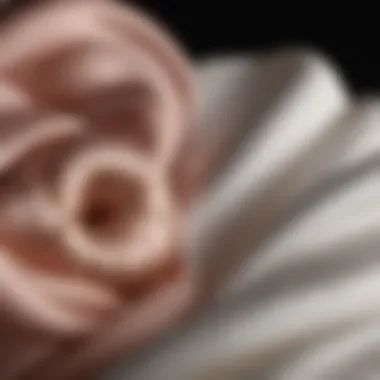Discover the Haircare Benefits of Silk Pillowcases


Intro
In recent years, silk pillowcases have gained considerable attention for their potential advantages in hair care. This trend is not simply about luxury; it has profound implications for health and beauty. Understanding the benefits of silk pillowcases requires a closer look at their unique properties that can influence the condition of hair.
Silk, as a fabric, has a smooth texture that decreases friction between your hair and the pillowcase. Unlike cotton, which can often snag and pull at strands, silk allows the hair to glide more freely. This reduction in friction leads to a myriad of positive outcomes, including lesser breakage and reduced frizz. Moreover, the temperature-regulating features of silk create a more comfortable sleep environment, which is crucial for overall hair health.
Through this article, we will explore these elements in detail, illustrating how silk pillowcases not only enhance the aesthetic appearance of your hair but also promote its health through better sleep conditions.
Benefits of Silk Pillowcases
Reduced Friction
Silk provides a gentle surface that minimizes friction. When hair moves against the fabric, it is less likely to experience tugging or pulling that can lead to damage over time. This is particularly vital for individuals with curly or textured hair, which is often more prone to breakage.
- Less Breakage: Since hair is less affected by friction, this leads to a decrease in daily breakage.
- Fewer Split Ends: Policies that decrease frizz can also limit the development of split ends, which ultimately means healthier hair overall.
Moisture Retention
Silk is known for its low absorbency compared to cotton. While cotton can draw moisture away from both skin and hair, silk helps to retain natural oils. For those with dry or curly hair types, this can be especially beneficial.
- Natural Oils: Maintaining these oils is important for keeping hair hydrated and looking its best.
- Hydrated Hair: Silk can support hydration, which results in shinier, healthier hair.
Comfort During Sleep
The sleep experience plays a significant role in hair health. Silk is softer and cooler than many other fabrics, which can enhance comfort. A comfortable sleeping environment contributes to better rest, essential for hair growth and overall health.
- Temperature Regulation: Silk can help regulate temperature throughout the night, which is essential for quality sleep.
- Allergy-Friendly: For those with sensitive skin or allergies, silk can be a gentler option, leading to an overall better sleep experience.
"Using silk pillowcases might just be the simplest upgrade to your beauty routine that can make a profound difference in your hair’s health."
The End
Silk pillowcases have multiple benefits that go beyond mere aesthetic appeal. By understanding how these pillowcases can lessen friction, retain moisture, and enhance sleep comfort, one can appreciate why they are increasingly recommended for hair care. Investing in silk pillowcases is not merely a luxurious choice; it is a practical step towards healthier hair.
Prolusion to Silk Pillowcases
The realm of hair care encompasses a myriad of products and practices, yet one aspect frequently overlooked is the impact of pillowcases. Silk pillowcases, while often seen as a luxury, hold remarkable benefits for hair health that merit attentive discussion. This section serves to elucidate the importance of silk pillowcases one practical consideration at a time.
Silk, with its smooth texture, minimizes friction between hair and the surface of the pillow. This reduction in friction means less hair breakage and tangling during sleep. Cotton and other fabrics tend to grab hair, leading to strands being pulled or snagged. Ultimately, the gentleness of silk can translate into a noticeable improvement in hair strength and appearance.
Another relevant aspect is the moisture-retaining properties of silk. Traditional fabrics can wick moisture away from the hair, leading to dryness and potential damage. Silk, on the other hand, helps to maintain the natural oils in hair, promoting a healthier shine and softness. This is especially beneficial for individuals with curly or textured hair, which can often be drier than other types.
Considering user comfort, silk also regulates temperature well. The breathability of silk helps to prevent overheating at night, further ensuring undisturbed rest. The quality of sleep has significant implications for overall health, including hair growth and vitality. A better sleep environment produced by silk pillowcases can indirectly benefit hair through improved overall wellness.
Understanding Hair Health
Hair health is a critical element in the pursuit of beauty and wellness. In this article, we will explore how silk pillowcases can impact hair health positively. Hair is not just a mere aesthetic feature; it reflects overall health and well-being. For many, it serves as an indicator of personal care and grooming habits. Understanding how hair functions and what influences its health will provide insight into how silk pillowcases can be particularly beneficial.
The Structure of Hair
Hair is composed mainly of a protein called keratin, which gives it strength and structure. Each strand of hair has three layers: the cuticle, cortex, and medulla. The cuticle is the outermost layer that protects the inner layers of hair. A healthy cuticle lies flat, allowing hair to shine. The cortex, which makes up most of the hair shaft, contains melanin, giving hair its color. The medulla, the innermost layer, is present in some types of hair, especially coarser strands.
Additionally, the condition of the cuticle significantly influences how the hair interacts with various surfaces, including pillows. When hair rubs against a rough surface, like cotton, the cuticle can become damaged, leading to frizz and breakage.
Factors Affecting Hair Health


Multiple factors play a role in hair health. These can vary from genetic predispositions to environmental conditions. Here are some key elements:
- Nutrition: A balanced diet rich in vitamins and minerals is vital for hair health. Nutrients like vitamins A, C, D, E, zinc, iron, and omega-3 fatty acids promote stronger, healthier strands.
- Hydration: Water intake is critical for maintaining moisture levels, not just in the body but also in the hair.
- Hair Care Products: The products used can either enhance or damage hair. Harsh chemicals may strip hair of its natural oils.
- Environmental Factors: Exposure to pollution, sun, and humidity can lead to hair damage and weakened strands.
- Stress: Stress can affect the hair cycle, potentially leading to hair loss.
- Styling Practices: Frequent use of heat-styling tools can lead to dry and brittle hair, while tight hairstyles can cause breakage.
Understanding these factors helps in recognizing how silk pillowcases can contribute to hair health. They provide a smoother surface for hair to rest on, reducing friction during sleep. This, combined with the protective nature of silk, reduces the potential for damage, leading to healthier hair over time.
"Silk pillowcases help in maintaining the hair's natural moisture and oils, something that cotton may absorb."
By being informed about hair health, individuals can make better choices about their hair care practices and enhance their hair wellness effectively.
The Science of Silk
Understanding the science behind silk is crucial to appreciating its advantages as a pillowcase material, especially for those concerned with hair health. Silk, a natural protein fiber produced by silkworms, offers unique properties that set it apart from other fabrics. These properties significantly contribute to the benefits experienced by individuals who opt for silk pillowcases.
Composition of Silk Fabric
Silk possesses a complex structure made primarily of fibroin and sericin. Fibroin, a structural protein, creates a smooth, lustrous surface that feels soft against the skin and hair. The sericin acts as a natural glue, holding the fibroin fibers together. This natural composition is hypoallergenic, allowing those with sensitive skin or allergies to use silk without adverse reactions.
The amino acids found in silk, such as glycine and alanine, have moisturizing properties that can be beneficial for hair. These amino acids assist in retaining hair moisture, preventing excessive drying that can lead to brittleness and breakage. Furthermore, the lightweight nature of silk ensures breathability, promoting a more comfortable sleep without trapping heat.
Differences Between Silk and Other Fabrics
The contrast between silk and other common pillowcase materials, such as cotton or polyester, is pronounced. Unlike cotton, silk's tightly woven fibers create a smoother surface that reduces friction. This reduction in friction is critical in preventing hair breakage and maintaining the integrity of hair shafts. On the other hand, cotton’s absorbent nature can draw moisture from hair, leaving it dry and prone to damage. Polyester, although soft, lacks the natural benefits of silk and can sleep hot, leading to discomfort throughout the night.
In summary, silk stands out as a premium option for pillowcases due to its unique composition and properties that support hair health. By understanding the science of silk, individuals can make informed decisions about their bedding choices, leading to better hair care outcomes.
Benefits of Silk Pillowcases for Hair
The significance of using silk pillowcases lies in their multifaceted benefits for hair health. As hair is particularly sensitive to friction and environmental factors, the choice of pillowcase can have a measurable impact on its condition. Silk, a natural protein fiber, creates a smooth surface that minimizes abrasion while you sleep. This is essential in reducing damage such as breakage and split ends, critical elements for maintaining beautiful hair.
Reduced Friction and Hair Breakage
Silk pillowcases offer a smooth texture that dramatically reduces friction on your hair. Unlike cotton, which can cause snagging, silk allows hair to glide across the surface. This reduction in friction can notably decrease hair breakage and tangling.
Individuals with curly or textured hair particularly benefit from this, as their hair accommodates more friction. Many studies indicate that the likelihood of hair damage may be directly related to the kind of fabric with which it comes into contact during sleep. A lower friction environment not only keeps hair more intact but also promotes a healthier sheen.
Moisture Retention
Silk possesses natural moisture-wicking properties. Traditional cotton can absorb moisture from hair, leaving it dry and frizzy by morning. In contrast, silk pillowcases do not draw away moisture. This helps keep both the hair and skin hydrated through the night.
Maintaining moisture balance is important because dry hair tends to become brittle. Regular use of silk pillowcases can significantly improve moisture retention. For people using hair products such as oils or leave-in conditioners, the benefits are magnified. They can wake up to softer, more manageable hair, enhancing overall hair health.
Minimizing Static and Flyaways
Another crucial aspect of silk pillowcases is their ability to minimize static and flyaways. The smooth surface of silk works to reduce static electricity, which is a common concern with other types of fabrics like cotton or polyester.
Less static means that hair is more likely to remain in place without unwanted frizz. For those who find themselves struggling with flyaways, the solution may lie in switching pillowcase materials. This simple change can lead to a more polished appearance consistently.
"Silk pillowcases are a beneficial investment for anyone seeking to maintain their hair's integrity while they sleep, proving both luxurious and practical."
Comparative Analysis with Cotton
The differences between silk and cotton pillowcases are pivotal for understanding the overall benefits for hair health. Given that both materials are widely used, it is essential to analyze how they operate differently and what that means for those concerned about their hair. This section sheds light on the unique advantages of silk over cotton, particularly in relation to hair damage and care.
Cotton Pillowcases and Hair Damage
Cotton is a natural fiber that is breathable and absorbent; however, these qualities do not necessarily favor hair health. The high absorbency in cotton means it pulls moisture away from the hair. This can lead to dryness, which compromises hair strength and elasticity. Moreover, cotton fibers are coarser than silk fibers. As hair moves against cotton during sleep, this friction can lead to breakage and split ends, especially for individuals with curly or frizzy hair types.


Research indicates that the properties of cotton can disrupt the natural oils in the hair, leading to an increase in frizz and making hair look unkempt. For individuals who style their hair or use products, certain oils and serums can be absorbed by cotton as well, diminishing their effectiveness overnight. Therefore, for those who prioritize hair health, understanding the limitations of cotton is crucial.
Why Silk Outperforms Cotton
Silk pillowcases present several distinct advantages over cotton when it comes to hair care. First, silk has a smoother surface, resulting in significantly reduced friction when the hair lies against it. This quality alone minimizes the potential for hair breakage and split ends, making it a wise choice for anyone looking to maintain hair integrity.
- Moisture Retention: Unlike cotton, silk does not absorb moisture from the hair. This helps in locking in hydration, which is crucial for maintaining healthy, shiny hair.
- Temperature Regulation: The natural properties of silk assist in regulating temperature. This means that individuals can benefit from a comfortable sleep environment, reducing sweating and promoting better sleep quality, which is vital for overall health.
- Hypoallergenic Properties: Silk is generally less likely to irritate the skin. For those with sensitive skin or scalp conditions, using silk can lead to fewer issues compared to cotton.
"Choosing silk over cotton can drastically influence hair vitality, offering benefits that extend beyond mere aesthetics."
In summary, while cotton has its merits, silk offers a superior alternative for those focused on hair health. The unique attributes of silk make it a preferable material, especially for individuals prone to hair damage or who have specific styling concerns.
User Experiences and Testimonials
User experiences and testimonials play a vital role in illustrating the actual benefits of using silk pillowcases for hair care. It is through the voices of those who integrate this luxury into their nightly routines that one can grasp the real-world implications of such choices. Objective data and anecdotal evidence come together to create a fuller picture, showing how factors like hair texture or scalp health can impact individual experiences with silk.
Real Stories from Silk Pillowcase Users
Many users have shared their transformative experiences after switching to silk pillowcases. A common theme among these testimonies is the noticeable reduction in hair breakage and frizz. For instance, Sarah, a curly hair enthusiast, found that her kinks and curls remained intact overnight without the usual tangling. She remarked, "I used to wake up with knots so bad that I was tempted to chop it all off. Now, my hair feels smooth and manageable every morning."
Another user, Lisa, highlighted the benefits of moisture retention. "I battle dry hair, especially in winter. Since using a silk pillowcase, my hair feels hydrated. I noticed less dryness and split ends."
These accounts reflect the real changes individuals undergo by introducing silk into their hair care routines.
Expert Opinions on Silk Benefits
Expert testimonies offer a scientific anchor to the experiences shared by users. Trichologists and dermatologists frequently recommend silk for its myriad benefits. Dr. Angelina Carter, a renowned trichologist, notes the unique properties of silk, stating, "Silk is naturally hypoallergenic and contains proteins that may benefit hair. It's significantly less abrasive than cotton, which can result in less wear and tear on hair strands."
Moreover, experts emphasize that silk’s low absorbency helps retain hair's natural oils. Dr. Mark Lewis, a dermatologist, clarifies, "Using silk pillowcases allows your hair to maintain its moisture levels, which is essential for healthy growth and shine."
In summary, user experiences are a powerful testament to the effectiveness of silk pillowcases for hair. Expert opinions provide the necessary credibility and underline the scientific rationale behind the popular testimonials. Together, they create a compelling case for considering silk as an integral part of one’s hair care regimen.
The Role of Silk in Overall Sleep Quality
Silk pillowcases not only benefit hair health but also significantly enhance overall sleep quality. Sleep is an essential aspect of life that affects mood, energy, and even skin health. Thus, the choice of bedding material can influence how well one sleeps. Silk offers unique properties that contribute positively to this aspect.
Comfort and Temperature Regulation
One of the primary advantages of silk is its softness and smooth texture. This comfort level can make all the difference in how quickly one falls asleep and how restful that sleep is. Unlike cotton, which can feel coarse or rough against the skin, silk provides a luxurious experience. The smooth surface of silk reduces friction against the skin and hair, resulting in less irritation.
Temperature regulation is another critical factor. Silk is a natural fiber that adapts to body temperature, helping to keep occupants cool in the summer and warm in the winter. This thermoregulating ability means that silk pillowcases can help maintain a comfortable sleep atmosphere, reducing the chance of waking up due to overheating or feeling too cold.
- Natural breathability: Silk allows air to flow, preventing the buildup of heat.
- Moisture management: Silk can absorb moisture from the skin, which is beneficial for maintaining skin hydration.
"Silk’s ability to maintain a balanced temperature is crucial for an uninterrupted sleep cycle."
Impact on Sleep Patterns
The quality of sleep can be affected by various factors, including stressors and physical discomfort. Silk pillowcases might help mitigate some common issues. The gentle feel of silk can be calming, potentially reducing stress before sleep. Additionally, the absence of irritating materials provides an environment that encourages prolonged restful sleep.
Proper sleep patterns are essential for overall well-being. Lack of quality sleep can lead to fatigue, irritability, and various health issues.
- Circadian Rhythm Regulation: A comfortable sleeping environment can assist in stabilizing the body’s internal clock, promoting consistent sleep schedules.
- Reduction of allergies: Silk is hypoallergenic, which means it can reduce allergic reactions for individuals sensitive to dust mites or other allergens found in fabrics like cotton.
Choosing a silk pillowcase can thus contribute to not only a better night's sleep but also better overall health.


How to Choose the Right Silk Pillowcase
Choosing the right silk pillowcase can greatly impact your hair health and overall comfort during sleep. Not all silk is created equal, and understanding the distinctions in quality and maintenance will ensure that you make a wise investment. This section will explore crucial factors that contribute to selecting the right product, emphasizing quality indicators and care considerations.
Quality Indicators in Silk Fabrics
When selecting a silk pillowcase, several characteristics signify high quality. Consider the following:
- Momme Weight: This measurement indicates the density of silk. Generally, a momme weight of 19 to 25 is preferable for pillowcases. Higher momme means a thicker pillowcase, enhancing durability and luxury.
- Type of Silk: Look for mulberry silk, which is widely regarded as the highest quality. It is produced by silkworms that are fed a specific diet, resulting in smoother, more durable fibers.
- Finish and Weave: Examine the silk’s weaving technique. A satin weave gives a smooth surface beneficial for hair, preventing friction. Ensure the fabric is free from any rough or scratchy areas.
- Certification: Seek out certifications ensuring the absence of harmful chemicals used in the production process. Look for OEKO-TEX Standard 100, which indicates that the materials have been tested for harmful substances.
Choosing a silk pillowcase involves more than just aesthetics. Understanding these quality indicators will help you make an informed choice that supports hair health.
Considerations for Care and Maintenance
Proper care and maintenance of your silk pillowcase are essential to preserve its quality and benefits. Here are some considerations to keep in mind:
- Washing Instructions: Always follow the washing instructions provided by the manufacturer. Generally, hand washing in cool water is recommended. If you use a washing machine, select a gentle cycle and place the pillowcase in a mesh laundry bag.
- Detergent Choice: Use a mild detergent specifically designed for silk. Avoid bleach or strong chemicals, as they can degrade the fabric.
- Drying Methods: Air drying is preferred. Avoid wringing out the pillowcase; instead, roll it gently in a towel to remove excess water. If using a dryer, opt for the lowest heat setting.
- Storage: Store your silk pillowcase in a cool, dry place away from direct sunlight. This practice prevents fading and maintains the pillowcase's integrity.
Maintaining your silk pillowcase correctly will increase its lifespan and effectiveness in supporting your hair health. A little effort can yield significant benefits.
Cost Analysis of Silk vs. Alternatives
When considering a silk pillowcase, the financial aspect becomes a notable factor in the decision-making process. Though silk pillowcases may have a higher upfront cost when compared to cotton or polyester options, it is crucial to examine the long-term benefits they offer, especially in terms of hair health and sleep quality.
Investing in silk is not just about the material; it represents a commitment to enhancing your overall sleep experience and caring for your hair. The right pillowcase can significantly reduce friction, helping maintain your hair's moisture and preventing breakage, which can lead to costly hair treatments and products in the future due to damage.
Short-Term vs. Long-Term Investment
For many, the initial investment in a silk pillowcase raises questions. Here are some points to consider:
- Durability: Silk is known for its longevity. While it may come with a higher price tag, authentic silk pillowcases can last much longer than their cotton counterparts. This durability means fewer replacements, which can be a cost-saving over time.
- Hair Health: Damaged hair often requires treatments, masks, and products, which add to ongoing costs. Silk pillowcases can reduce hair damage, thus minimizing the need for expensive remedies and allowing hair care routines to be simpler and less expensive.
- Comfort Benefits: The luxurious feel of silk may also improve your sleep quality. A better nights’ rest contributes to overall well-being, which is invaluable. If you sleep better, you may find fewer health-related expenses in the long run.
Evaluating Value Based on Benefits
When assessing the value of silk pillowcases, consider the following benefits:
- Reduced Friction: The smooth surface of silk minimizes friction against hair, which can lead to less breakage and frizz. The value of fewer bad hair days is immeasurable for many individuals.
- Thermal Regulation: Silk naturally helps with temperature regulation. It can keep you cooler in warmer climates yet provide warmth during colder months, making it useful year-round. This adaptability enhances the overall value of your purchase.
- Reduced Maintenance Costs: With diminished hair damage, the need for specialized hair products decreases. This shifts your spending focus from frequent beauty product purchases to investing in a quality silk pillowcase.
- Aesthetic Appeal: Silk pillowcases generally provide a more elegant look compared to standard cotton options, enhancing the bedroom's decor. This aesthetic value might be important for some users.
"Investing in silk pillowcases is not just about immediate returns; it's about recognizing the compounded benefits over time."
Epilogue: Is a Silk Pillowcase Right for You?
Determining whether a silk pillowcase is well-suited for you involves a careful consideration of its advantages and your individual needs. Silk pillowcases can deliver notable benefits, especially in the realms of hair health and comfort during sleep. The primary attributes of silk, such as its smooth texture and moisture-retaining properties, offer a stark contrast to traditional materials like cotton. For many individuals, the reduction in friction can translate to less hair breakage and fewer split ends. Moreover, silk can help retain the natural oils that your hair produces, thereby promoting a healthier shiny appearance.
However, potential users should also take into account factors such as their budget and personal preferences. While silk pillowcases may command a higher price point than standard options, the long-term benefits they provide could justify the investment. Additionally, for those who struggle with allergies or sensitive skin, the hypoallergenic nature of silk may give further impetus to make the switch.
"Choosing a silk pillowcase is not just a matter of luxury; it is a step toward better hair care and potential long-term savings on hair treatments."
In summary, assessing the right choice for your bedding requires a blend of evaluating scientific evidence with personal circumstances.
Summarizing the Key Points
In summarizing the essential points made throughout this article, several key benefits of silk pillowcases emerge:
- Reduced friction: The smooth surface of silk minimizes hair breakage while you sleep.
- Moisture retention: Silk helps maintain essential oils that are vital for hair shine and health.
- Hypoallergenic properties: This material can assist in preventing irritation for sensitive skin types.
- Long-term investment: Although silk pillowcases may seem pricey, their potential for enhancing hair health can lead to savings in hair care costs.
In essence, silk pillowcases emerge as a compelling choice for those concerned with hair health, ensuring a balance between beauty and practicality.
Final Thoughts on Hair Care
Ultimately, investing in a silk pillowcase is about understanding its role in your overall hair care routine. While many products can offer temporary solutions to hair problems, a silk pillowcase provides a foundational approach that addresses hair health at a deeper level. The fabric not only aids in reducing physical damage but also complements other hair care practices you may already be engaged in.
Consider this: adopting a comprehensive hair care plan that includes the use of silk pillowcases could yield significant results in the long run. The health of your hair is a long-term commitment, and every small change contributes to that journey.







